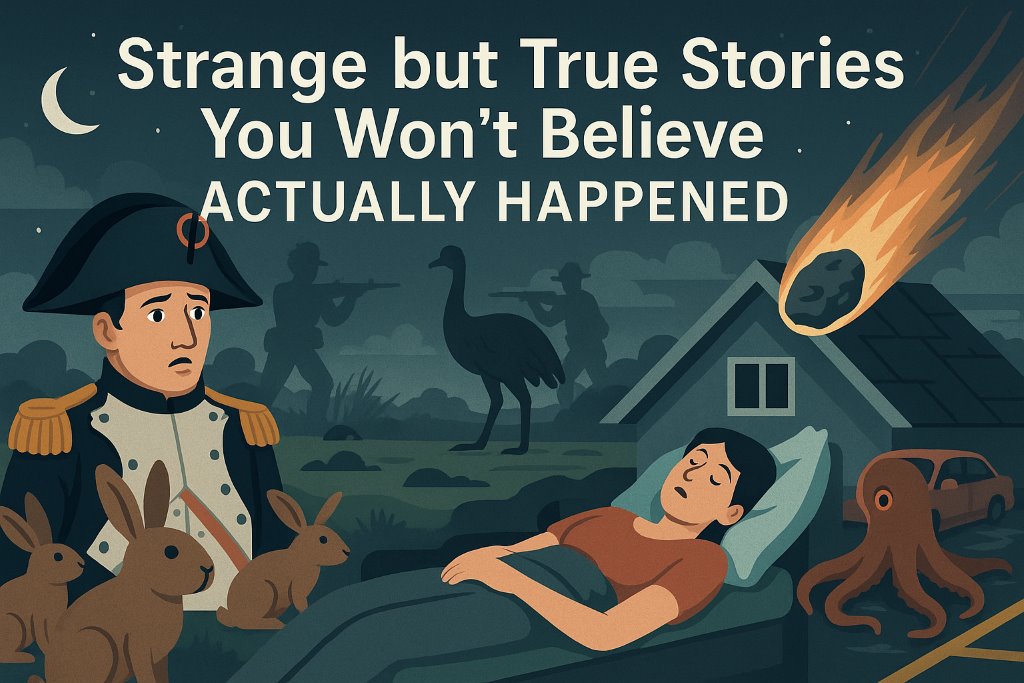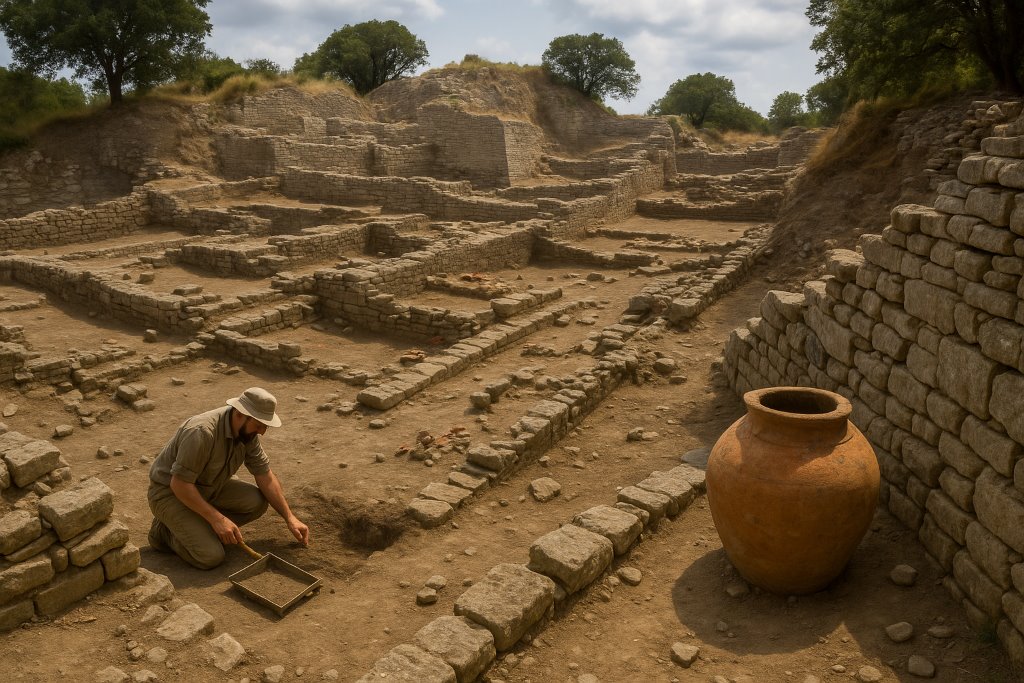
Strange but True Stories You Won’t Believe Actually Happened
The world keeps handing us strange but true stories that feel like misprints in reality. One leader is chased by hungry rabbits, a nation fights a bird and loses, a woman survives a meteorite falling through her roof. I think part of the appeal is that none of this asks for suspension of disbelief. It all happened, which is a little unsettling and a little addictive. What follows is a mix of historical oddities and modern headlines that still raise eyebrows. By the time you’re done, you might find yourself collecting your own list of strange but true stories.
Strange but True Stories in History
Plenty of strange but true stories in history sit right there in the archives, recorded by officials who were doing their best not to sound surprised. These aren’t fables. They are documented incidents that survived the edit of time. I’ll start with a few that always make people blink, then read the sources twice.
Napoleon’s rabbit disaster
In 1807, after the Treaty of Tilsit, Napoleon agreed to a celebratory rabbit hunt for himself and his officers. Staff gathered hundreds of tame rabbits. When the cages opened, the animals ran toward the emperor instead of away. They swarmed boots and coats, climbed uniforms, and kept charging the carriages. The hunt turned into a retreat. It reads like slapstick, yet the accounts hold up. For a conqueror who controlled half of Europe, being overrun by friendly rabbits is almost poetic.
The Great Emu War
Western Australia, 1932. Farmers were losing crops to emus. The government sent soldiers with machine guns to push the birds back. On paper, the plan looked simple. In practice, the emus moved in scattered groups, sprinted fast, and absorbed the chaos like veterans. The soldiers expended plenty of ammunition and achieved almost nothing. After a few awkward field reports, the operation ended. The emus kept the fields. If you want a straight reference, try Medium. It is exactly as ridiculous as it sounds.
The Dancing Plague of 1518
Strasbourg saw one of the most puzzling mass events in early modern Europe. A woman began dancing in the street with no music. Others joined. Then dozens. People danced until feet bled and bodies dropped. City leaders tried music to channel it into a festival. That made it worse. Explanations range from ergot poisoning to collective stress. No single theory covers the full picture. I don’t mind the uncertainty here. It fits the mood of the story.
Operation Paul Bunyan
In 1976, a poplar tree in the Korean Demilitarized Zone became the center of a deadly incident. When two American officers were killed while trimming it, the response was not delicate. Engineers arrived with chainsaws backed by helicopters, infantry, and vehicles, all to remove one tree while making a point. The show of force worked. No one fired. The tree came down. The entire operation lasted about 45 minutes and reads like a very tense stage play.
The Cadaver Synod
Ninth-century Rome staged a posthumous trial for Pope Formosus. His corpse was exhumed, dressed in papal robes, and seated on a throne while another pope presided. A deacon answered for the deceased. The body was found guilty, the consecrations annulled, and the remains tossed into the Tiber. It is grim, theatrical, and entirely recorded by clerics who must have wondered what on earth they were witnessing.
You could add more strange but true stories from history to this shelf: a molasses flood that destroyed part of Boston, a volcano that turned summer into a winter-like season, a medieval menagerie that kept exotic beasts in royal towers. The pattern is the same. Reality refuses to stay tidy.
History is full of episodes just as strange – if you want more, take a look at our collection of weird historical facts.
Strange but True News Stories
Plenty of strange but true news stories feel like internet myths until you look up the original reports. These aren’t folklore. They were written by local papers, logged by police, or studied later by researchers with very patient notes.
Florida Man and the lawn mower arrest
The phrase became a meme for a reason. One headline told of an arrest for driving under the influence on a lawn mower. It wasn’t a first offense. There are others just as odd, including alligator encounters, fast-food standoffs, and improvised vehicles. Not every headline is fair to the people involved, but the cluster of stories is real. It turned into a modern shorthand for offbeat human behavior recorded in official logs.
The woman struck by a meteorite
Ann Hodges of Sylacauga, Alabama, was napping on her couch in 1954 when a meteorite crashed through the roof, bounced off a radio, and hit her hip. Bruises, shock, a lot of explanations to neighbors. She became the first confirmed person to be hit by a meteorite. If you want a clean reference, see National Geographic post. Space debris rarely reaches people. That day, it did.
Three days in an underwater air pocket
In 2013, a tugboat capsized off Nigeria. Cook Harrison Okene survived in a small air pocket inside the wreck, alone in cold water, pitch black, listening to the sounds of the sea and distant salvage work. Rescuers found him after roughly 60 hours. The footage of his discovery spread fast. I still think about the quiet, the patience, and the relief when a hand finally reached out of the dark.
The octopus in the parking lot
Floodwater can carry sea creatures far inland. In one coastal city in China, storm surges left an octopus in a supermarket parking lot. Photos made the rounds online. It was rescued and returned to the water. The image is strange enough to feel staged, but the weather that day was severe and the coastline not far away. Sometimes the sea just decides to visit.
Famous Strange but Mostly True Stories
There is a category I like to call strange but mostly true stories because the core is documented, even if popular retellings add a dramatic garnish. These sit in the middle space between myth and confirmed fact, where a single excavation or a careful review can tilt the balance.
Troy was not a fantasy city

For a long time, many treated the Trojan War as literature. Then excavations in the late 19th century uncovered a layered city in modern Turkey, with signs of fires and conflict. Homer’s full saga is still poetry, but the place existed. Later archaeology refined the timelines and added context. If you like patient scholarship, read the BBC’s summary or the British Museum’s overview. The point is simple: the legendary city was real, even if the wooden horse is still a matter of debate.
A vampire scare in New England

In 19th-century Rhode Island and surrounding areas, tuberculosis ripped through families. People didn’t understand the disease. Some communities turned to old beliefs, exhumed relatives, and looked for signs that the dead were feeding on the living. Mercy Brown’s case in 1892 is the most widely cited. Her heart was removed and burned. It reads like gothic fiction. It was a desperate public health mistake recorded by local papers and physicians.
The Boston Molasses Flood

January 1919, Boston’s North End. A massive tank of molasses ruptured, sending a sticky wave through streets at surprising speed. People and horses were swept away. Buildings were damaged. Rescue was difficult. The cleanup took weeks, and the smell lingered. When someone says history is dry, this is a solid counterexample. It was industrial negligence, not folklore, and it changed safety standards.
The sailing stones of Death Valley

For decades, people found rocks with long tracks behind them on Racetrack Playa. No one saw them move. Theories ranged from pranksters to magnetism. Careful time-lapse and instrumentation eventually captured the mechanism: thin ice sheets, light winds, and water at just the right depth. The rocks slide slowly. Mystery solved, but not ruined. I like it more now, honestly.
Why We Love Strange but True Stories
I have a small stack of collections on my shelf, including at least one strange but true stories book picked up in a museum shop when I should have been buying something practical. These stories work because they short-circuit our sense of what is likely. They also travel well. A rabbit swarm, a molasses tide, a parking lot octopus. You can retell them without charts or jargon, and people lean in.
There is another reason. Odd episodes are often gateways to serious subjects. The Emu War opens a conversation about wildlife management and politics under pressure. The vampire scare points to fear, grief, and the long history of disease. The Dancing Plague nudges us toward the psychology of crowds and the strain of hard years. A good headline pulls you in, and then you notice the deeper thread running under it.
Also, the mix matters. A list of only accidents and disasters leaves you a bit numb. A list of only charming oddities feels flimsy. Together, they feel like life: tragic on one page, ridiculous on the next. Perhaps that is why editors return to these topics again and again, and why readers keep sharing them.
Quick picks to copy for later
For your own notes, here is a compact roll call you can reuse, with one-line reminders attached so you remember which is which:
- Napoleon’s rabbits – a hunt turns into a furry siege.
- The Great Emu War – birds outmaneuver soldiers, crops still eaten.
- Dancing Plague – crowds dancing to collapse, cause still disputed.
- Operation Paul Bunyan – chainsaws with an armored escort.
- Cadaver Synod – a trial for a dead pope, verdict delivered.
- Molasses Flood – industrial failure, sticky disaster, new rules.
- Sailing stones – ice, wind, shallow water, slow motion geology.
- Meteorite strike – a couch, a hole in the roof, a bruise that made history.
- Underwater air pocket – three days in the dark, then a hand appears.
- Parking lot octopus – storm surge, a photo, a rescue back to the sea.
Frequently asked doubts I hear
Did Australia really lose a war to emus? Yes. It was an operation with military resources against birds, and the outcome favored the birds. It is funny on the surface and frustrating underneath.
Was the meteorite story confirmed? Yes. Ann Hodges’ case is well documented by local authorities, press clippings, and later science pieces. It is the classic example used in articles about rare impacts.
Is there proof the Dancing Plague wasn’t staged? The municipal records, religious notes, and later medical reviews point to a real event with real casualties. The exact trigger remains debated.
Are there more cases like the underwater survival? A few. Air pockets can form in wrecks. Rescue is delicate and rare. If you want a short primer, read coverage by outlets that interviewed the dive teams who were there.
Famous Strange but Mostly True Stories
Let me return to strange but mostly true stories for a moment, because this category keeps growing. Archaeologists keep turning up evidence for places we thought were only poetic, while skeptics keep trimming legends back to a factual core. Heracleion, a drowned Egyptian city, was long rumored and then mapped. Viking outposts in North America moved from speculation to artifacts. It is fair to be cautious with big claims, and also fair to admit the world still hides things.
A short note on how to read these
When a story sounds wild, I usually look for two things. First, a primary source or a solid secondary write-up by a reputable outlet. Second, a simple explanation that does not require a conspiracy. Most of the time, that is enough to sort the solid from the shaky. If the only support is a single blog post that cites another blog post, I pass.
Conclusion
We keep telling each other strange but true stories because they make the world feel bigger and less predictable. A leader can be chased by rabbits, a city can drown in syrup, a stone can skate across a dry lake while no one is looking. Some of these tales spark a smile, some leave a chill, and a few do both. Either way, they stay with us. If you want to go deeper, try pieces from History.com and BBC Future. They tend to get the details right without draining the curiosity out of the story.







